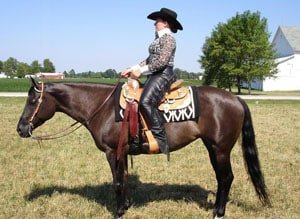
So, you’ve decided you want to start going to horse shows. That’s fantastic! But where do you start? Many trainers go to a horse show at least once a month. But, if you don’t have a trainer that is intimately involved in showing, it can be difficult to get started.
How to Prepare for Your First Horse Show
1. Decide what classes you want to compete in
Do you want to compete in western or English? This is an important distinction. Some areas of the country have more western horse shows while others have more English horse shows. But just knowing western versus English isn’t everything. If you want to compete western, do you want to barrel race? Rope? Cut cows? Pleasure? Ranch Horse? Team penning? If you want to compete in English, do you want to do dressage? Jumping? Hunter? Cross country? Eventing? The options for both are virtually endless, so it is important to narrow down your choices.
2. Find local shows in your area
Search for events in your area that offer the classes you are looking for. Also, know how far you are willing to travel and how much you are willing to pay per class before starting your search. Be sure to factor in gas to get there and any extra fees such as stall fees, judges fees, grounds fees, association memberships, and any number of other fees that may or may not be required.
3. Get a copy of the rule book
Many smaller all-breed shows in the US follow AQHA rules. It is important to know what rules your chosen event follows so you can get your hands on the rule book beforehand and be fully prepared. You may have the call the event office of the fairground or association who is putting on the show. Once you know what rule book they follow, a quick Google search is generally all it takes to find a free digital copy of most rule books. Here is a list of some of the most common rule books used in both western and English disciplines:
AQHA American Quarter Horse Association Rule Book
NSBA National Snaffle Bit Association Rule Book
NRCHA National Reined Cow Horse Association Rule Book – 2020
NCHA National Cutting Horse Association Rule Book – 2020
NRHA National Reining Horse Association Rule Book
4. Find out what patterns you need to know
Many classes at the horse show will require some type of pattern. Whether you are competing in reining, jumping, cow horse, or barrel racing, you should always know your pattern before the day of the show. Break it down into its individual parts in the practice pen. Never wait until the day of the show and just wing it.
A class like barrel racing does the same pattern every time. However, a class like cow horse or reining has several patterns that the judge can choose from. Jumping classes may not have any set patterns, but they do have set elements for each level of jumping. Many times, you will not know what pattern you will be expected to perform on the day of the show. This is why breaking all the patterns down into their elements is vitally important. Practice stringing those elements together into different patterns. Practice the set patterns in the rule book as well as some new patterns of your own making.
[clickToTweet tweet=”When practicing for a horse show, keep mixing it up so your horse does not learn to anticipate the patterns.” quote=”When practicing for a horse show, keep mixing it up so your horse does not learn to anticipate the patterns.”]
5. Go watch a few shows
Go to at least one show as a spectator. Also pay particular attention to the classes you are hoping to compete in. Observe how the show is run. Here are a few questions you should investigate while you are there:
Questions About How the Horse Show is Run
Is your class one where all the competitors are in the ring together? Or does each person go in one at a time? If they go in one at a time, do they want everyone lined up and waiting at the gait for their turn?
How long will they wait for you if you are late for your class?
Are there food stands or are you expected to pack a lunch?
Does the show management seem organized? Do the judges seem to know what they are doing?
Do there seem to be a lot of children and pets running around underfoot?
Questions About Horse Care and Safety
Are there adequate water sources around or will you have to haul water from the other side of the show grounds? Does the water seem good quality? Would it simply be easier to bring water from home?
Does there seem to be adequate space between the trailers or is the parking area so packed there is barely room to move?
Is a show where you tie your horse to the trailer for the day? Also note whether your horse will be standing on grass, dirt, or gravel.
Are there stalls? Do you need to bring your own bedding or is it provided? If it is provided is it good quality and also how much does it cost? Do the stalls seem secure? Are they safe? What is the stall floor like? Is it concrete or dirt?
Is the horse show held in conjunction with a fair? If so, are there big crowds and noisy rides to be concerned about?
6. Make a list of things you will need to take to the horse show
This includes, but is not limited to:
- saddle
- saddle pad
- bridle
- grooming supplies (brushes, combs, conditioners, mane bands, etc.)
- first-aid supplies
- your show clothes
- muck boots
- manure fork
- manure bucket
- water buckets (at least 2)
- hay
- hay net
- feed
- feed pan
- extra reins
- extra saddle pad
- tack repair kit including leather strings, chicago screws, etc.
- leather cleaner
- stain remover for the horse
- stain remover for your clothes
Things You Should Be Aware of Before Going to Your First Horse Show
1. Winning doesn’t always happen right away
Sometimes you get lucky. If you start out at fun shows, you are more likely to win those first place ribbons first time out. But, for many people, winning won’t happen right away. That’s ok. The pressure of a show atmosphere takes some getting used to. Go to your first show with no expectations. If you come home with ribbons, fantastic! But if you don’t, you will still have gained a valuable learning experience.
2. It’s addicting
The worst part about this addiction is there is no treatment. It will suck your wallet dry in a heartbeat and leave you penniless, but still craving more.
Cover Photo by anniejay









